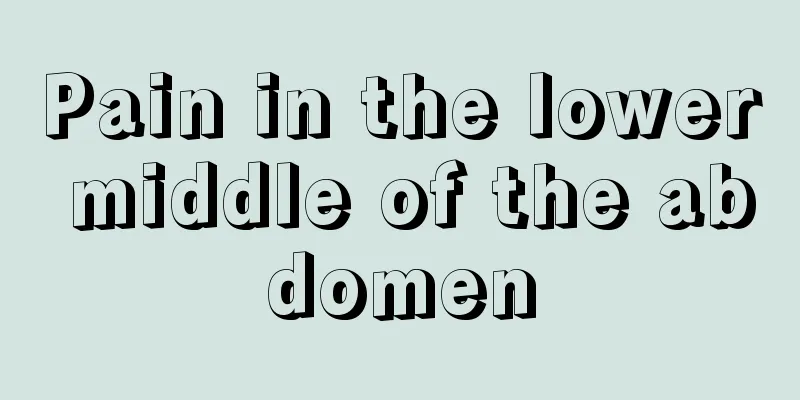Pain in the lower middle of the abdomen

|
Many women experience pain in the lower middle of their abdomen. In fact, the occurrence of such symptoms may be normal or abnormal. For example, ovulation abdominal pain and dysmenorrhea are normal physical conditions. Of course, if it is a gynecological disease such as pelvic inflammatory disease or adnexitis, then you need to go to the hospital for treatment in time. Below, I will introduce to you the common causes of lower abdominal pain! 1. Ovulation abdominal pain The ovulation period is about two weeks before menstruation. At this time, the follicle ruptures and the follicular fluid stimulates the peritoneum, causing women to experience mild abdominal pain alternating between the left and right sides once a month, mostly manifested as dull pain or heaviness on one side of the lower abdomen. The pain can last from a few hours to no more than 2 days. This pain is a physiological problem, so there is no need to worry too much and no treatment is required. 2. Dysmenorrhea Every woman will experience dysmenorrhea to a greater or lesser extent, and dysmenorrhea can be divided into two types: primary and secondary. The former is more common in unmarried girls and will be alleviated after marriage and childbirth. However, if you have dysmenorrhea after marriage, you should be careful of gynecological diseases. The most common one is endometriosis, which is secondary dysmenorrhea. The pain will gradually worsen. You will also have dull pain in the lower abdomen during non-menstrual period, and it will worsen before and after menstruation. This pain needs treatment. 3. Chronic pelvic inflammatory disease The lower abdominal pain caused by chronic pelvic inflammatory disease (mostly manifested as lower abdominal pain) is generally aggravated after fatigue, sexual intercourse, and before and after menstruation. Many people will feel tired and insomnia, which requires examination and treatment. Generally, the Chinese medicine Jinji Capsule can be chosen for treatment. It contains ingredients such as golden cherry root, Millettia reticulata, and Zanthoxylum bungeanum. It has the effects of clearing away heat and detoxifying, strengthening the spleen and removing dampness, and dredge meridians and promote blood circulation. It is effective in treating pelvic inflammatory disease and adnexitis. IV. IUD incarceration After a woman reaches the age of 40, her cervix and uterus will gradually shrink. If the size of the IUD does not change, it will get stuck in the uterus or even become ectopic, accompanied by low back pain, abdominal pain, lower abdominal distension, or irregular bleeding. 5. Adnexitis Women who often experience lower abdominal pain should be alert to whether they have adnexitis. Adnexitis can cause lower abdominal pain in patients, and also symptoms of abnormal leucorrhea. Adnexitis is mainly caused by unclean sexual behavior or multiple abortions. If you have lower abdominal pain, you should go to the hospital for relevant examinations. Women should pay attention to screening for gynecological diseases. |
<<: What is the difference between vaginal bleeding and menstruation?
>>: Can girls soak their feet during their period?
Recommend
A magic weapon for women's health after 40
For women, "menopause" is equivalent to...
Are multiple cervical cysts serious?
Many women do not know much about multiple cervic...
Vitamin C cured my fungus
Candidal vaginitis is a common gynecological dise...
Can I eat figs during menstruation?
Speaking of figs, everyone is familiar with them ...
What does a girl's private part look like?
Everyone's appearance and organs are differen...
What is the normal value of endometrium?
The endometrium is located in the uterus and is a...
What brand of brandy is good? What is the alcohol content of brandy?
Brandy is made from fruit wine and has a strong a...
Can a woman who has had an abortion keep it?
Sexual desire is a normal physiological desire of...
What is the difference between salpingography and hydrosalpingography?
If a woman suffers from infertility for a long ti...
Why do I have blood clots during my period?
Menstruation is a common physiological characteri...
The benefits of moxibustion on the lower back of women
Moxibustion is a common method of health care and...
When is the fastest time to react to pregnancy?
Whether it is an unexpected pregnant mother or a ...
How to open the door of a drum washing machine when adding clothes? How to save electricity when using a drum washing machine
Is it possible to add new clothes to the drum was...
What to do if pregnant woman has runny nose and sore throat
During pregnancy, although the pregnant woman'...
Precautions for fallopian tube removal surgery
Fallopian tube removal surgery is a surgery that ...









